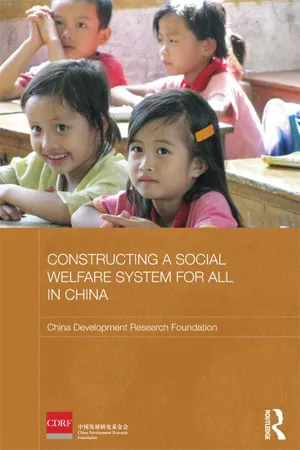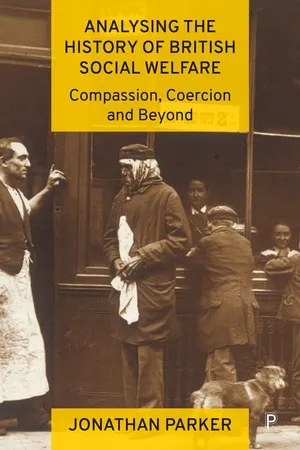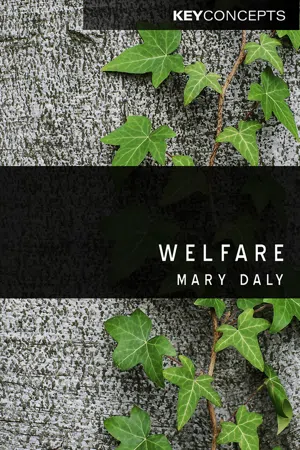History
Welfare Reforms
Welfare reforms refer to changes made to government social welfare programs and policies. These changes are aimed at improving the efficiency, effectiveness, and equity of welfare systems. Welfare reforms can include adjustments to eligibility criteria, benefit levels, and the structure of welfare programs. They are often driven by social, economic, and political factors, and can have significant impacts on individuals and communities.
Written by Perlego with AI-assistance
Related key terms
Related key terms
1 of 4
Related key terms
1 of 3
5 Key excerpts on "Welfare Reforms"
- China Development Research Foundation(Author)
- 2013(Publication Date)
- Routledge(Publisher)
3 The course of development andreforms made in other socialwelfare systems in the world
Social welfare has undergone a long developmental process in different countries in the world, and has seen continuous reform and adjustment. It was originally designed to reduce the personal income risk caused by marketization and industrialization, to maintain social stability and protect the rights of citizens. Countries are now increasingly concerned about the financial affordability and sustainability of their systems. More importantly, many people are now viewing welfare systems in a proactive light, as a way to increase social investment in human resources, improve economic competitiveness, and boost economic development. Welfare systems are regarded less and less as passive measures, set up mainly to deal with the negative effects of economic cycles.History of social welfare systems
The concept and practice of social welfare has a long history. In the ancient Egyptian, Mesopotamian and Greek civilizations, people had already formulated and practiced some basic welfare systems to help the poor and the weak and reduce social contradictions. In China, during the Xia, Shang and Zhou dynasties, State expenditures included spending on famine relief. Modern social welfare systems emerged in tandem with industrialization and the rise of market-oriented economies. Industrialization caused large-scale mobility of people, unemployment in urban areas, and severe poverty, which impacted social stability and forced early industrialized countries to begin social interventions. In 1601 Britain promulgated the first Poor Law. According to that law, each parish was responsible for levying a ‘poor tax’ on residents and real estate owners in order to give relief to those who were unable to make a living. This was the earliest legislation that dealt with formal intervention by a government in social welfare via basic living allowances. In 1834 Britain adopted The Poor Law Amendment Act- eBook - ePub
Constructing the Welfare State in the British Press
Boundaries and Metaphors in Political Discourse
- Malgorzata Paprota(Author)
- 2020(Publication Date)
- Bloomsbury Academic(Publisher)
There are several texts on reforms by government officials in the corpus. Among these, a February 2011 column in the Telegraph by Iain Duncan Smith (Minister for Work and Pensions) introduces the Welfare Reform Bill, and a December 2012 column by the same author introduces the Universal Credit. Two texts from the peak month of April 2013 – a Telegraph column penned jointly by George Osborne and Duncan Smith, and a Guardian column by Esther McVey (Minister for Disabled People) – outline and justify the April reforms package (see Chapter 1). These texts (the April columns in particular) encapsulate argumentation that typifies the Coalition’s discourse of welfare reform, where the welfare state, consistently synonymous to the social security system, is deficient and needs to be reformed on specific economic and moral grounds besides its cost: effectiveness and fairness. The opening sentence of the joint 2013 Telegraph column identifies the object of the reform as ‘our tax and benefits system’. A reference chain connects ‘fixing the benefits system’ in the title, ‘fixing the welfare system’, and ‘restoring the original principles to the welfare state’. The last of these specifies the impact of the intervention, and so a strong association is created between social security and the welfare state. Welfare reform, seeking to address the deficiency of the system, is the focus of the first half of the article; other entities to be reformed are somewhat less defined and include banks as well as the fiscal system. The deficiency of thus-constructed welfare state consists primarily in that it is unfair: there is only a perfunctory reference to dependency on benefits and the need to help claimants into work, and the savings resulting from the reforms are estimated but not devoted much space. The references to fairness as the primary rationale for the reforms recur, however, and are both explicit and implicit - eBook - ePub
Analysing the History of British Social Welfare
Compassion, Coercion and Beyond
- Jonathan Parker(Author)
- 2023(Publication Date)
- Policy Press(Publisher)
2A brief history of British social welfare
Social welfare, concern for the well-being of others, permeates human history. It says much about what we are as a species and how we organise our social ecologies. It helps us learn how people construct the world, design, develop and implement its systems that assists us in responding to changing situations, and, from knowledge of the past, to address future social needs. We present, here, an overview of key shifts in human compassion and social welfare from early archaeological records, the development of organised religious charity, state-organisation and politicisation of welfare in the Poor Laws, the development of the welfare state, the demise of the assumed welfare ‘consensus’, and the growth of neoliberal and marketised approaches. The focus is thematic and chronological, identifying some of the discourses, ambivalences and continuities that permeate these histories and the functions they provide.Care and welfare before human recorded histories
Pinker (1979/2021) posited, with a nod to ambivalence, that social welfare is embedded in our social transactions and loyalties, representing both egoism and altruism, or functional, self-interested approaches as well compassion. He challenged conventional ideas that welfare began with social policy interventions, latterly delivered through welfare states. Similarly, Finkel (2019) argued that compassion represents a core feature of human societies through the ages. As we noted in Chapter 1 , social policy concerns the different ways in which human interaction is codified and embedded into the social fabric. Once this happens, various political discourses frame and shape the workings of social welfare and attach differing values and responsibilities to giving and receiving it. However, the archaeological record, our window into societies before the written word, indicates that people who were sick, disabled or in need were looked after in societies in which hunger, drought and danger were everyday challenges. For instance, Cassidy et al (2020) report identifying a young, still breastfeeding male infant from Poulnabrone in Ireland with a clear trisomy of chromosome 21, which they believe is the earliest example of a case of Down’s syndrome. While the child died at around six months, he was buried in a large Neolithic burial mound that indicates privilege and which suggests, despite his disability and however this was recognised at that time, he was valued. Similarly, Tilley and Nystrom (2018) - 1 Founding Ideas and ApproachesThis chapter introduces welfare by outlining its most enduring representations in academic work. As it develops, the chapter tilts towards the historical – the intention is to pinpoint the long-standing concerns that are evoked by welfare and the scholarly approaches through which these have been identified, examined and developed. Following a brief outline of a range of definitions, the second section of the chapter takes us in turn through a discussion of welfare viewed as economic, as a philosophical and political ideal, and as a response to perceived social problems and social ills. In its third part, the chapter engages further with the concept by considering some enduring questions that it raises. These probe the relative vs universal nature of welfare, whether it should be thought of in relation to individuals or collectivities, and the matter of whose responsibility it is to provide welfare. We shall see that the concept has a range of meanings and that it is a site of competing accounts and visions.Origins and Meanings of WelfareThe origins of the term can be traced back at least to the fourteenth century when it meant to fare or journey well (Williams 1976: 281). There is a dual sense of welfare here as both condition and process – captured if we hyphenate the word: wel-fare. Over time, welfare has acquired a diverse set of meanings. Among its many popular references now are material sufficiency, well-being, the absence of negative conditions, physical and mental health, satisfaction of desires, and provision for need within the context of organised services for the needy and the population more broadly.As mentioned, welfare as a term is not as widely used now as in the past. In the 1970s and 1980s, there were far more publications with ‘welfare’ in the title as compared with the present period, for instance. There are other indications also that the concept has fallen out of favour. As Dean views it (2006: 21), recent ideological controversy over the nature and purpose of social policies has seen welfare acquire a pejorative connotation. This is true especially in the US, where the term has a powerful negative charge. Its American usage is associated with both safety-net or means-tested benefits and people who depend on them for their income. When this view is unpicked, a connected set of assumptions is revealed. Three such assumptions are noteworthy.
- eBook - ePub
The Promise of Welfare Reform
Political Rhetoric and the Reality of Poverty in the Twenty-First Century
- Elizabeth Segal(Author)
- 2006(Publication Date)
- Routledge(Publisher)
Since entitlement programs strengthen the infrastructure of the welfare state, the conversion of AFDC from an entitlement program into a block grant also posed a threat to the social welfare programs serving the middle class. With hindsight it is clear that the elimination of the unpopular welfare entitlement was just the first step on a slippery slope to undoing the more popular and more generous entitlement programs. Following welfare reform, the nation’s leaders set their sights on ending an individual’s entitlement to Social Security and Medicare by privatizing the programs all or in part. The Bush administration and many in Congress hope to transfer responsibility for these programs from the federal government to individuals and the private sector. There is also talk of turning Medicaid and Section 8 housing vouchers into a block grant. In the name of “reform” these changes promise both to increase the economic insecurity of millions of people and to erode the foundation of the U.S. welfare state. The attack on the welfare state advances still another neoliberal goal— discrediting the general regulatory powers of the federal government and reducing its scale and scope. When allowed to operate, government regulations usefully protect families, consumers, workers, and the environment from the various negative impact of the profit-driven practices of corporate America.The Race CardThe welfare reformers built public support for welfare reform that threatened the well-being of the middle class as well as the poor by, among other things, playing the race card. Aided and abetted by the media, the reformers tapped into decades of invidious racial stereotypes to turn poverty and welfare into a “black problem” which effectively divided the public along race lines (Gilens, 1999).The practice has a long history. In 1935 the landmark Social Security Act excluded farm laborers and domestic workers with impunity—the two main occupations open to blacks and Latinos at the time. In the 1940s and 1950s southern welfare offices shut down during the cotton and tobacco harvests to ensure a steady supply of black labor. In the early 1960s more than a few states with large black welfare caseloads threw women off welfare for having children on their own (Abramovitz, 1996).
Index pages curate the most relevant extracts from our library of academic textbooks. They’ve been created using an in-house natural language model (NLM), each adding context and meaning to key research topics.
Explore more topic indexes
Explore more topic indexes
1 of 6
Explore more topic indexes
1 of 4




